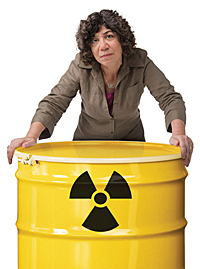sierraclub.org - sierra magazine - november/december 2010 - mixed media
Know Your Nukes | Earth Beat
 Photo: Aaron Clamage; illustration: John Ueland
Photo: Aaron Clamage; illustration: John Ueland
Know Your Nukes
Climate concerns rekindle the nuclear debate
You may not have given much thought to nuclear power since Three Mile Island and Chernobyl sent the industry into a deep sleep some 20 years ago, but what's old is new again.
With the perils of global warming looming, nuke's boosters have excitedly repurposed fission as a reliable low-carbon alternative to coal and natural gas. Investment gurus tout uranium-mining stocks as the next big thing. Politicians eye nuclear as a solution to U.S. dependence on foreign oil. With federal loan guarantees forthcoming, the Nuclear Regulatory Commission is bursting out of its headquarters as hundreds of new hires shepherd construction applications.
The Sierra Club and others point out that the resurgent nuclear industry is no closer to finding a way to safely dispose of its long-lasting, highly radioactive waste than it was 50 years ago and that nuclear power remains prohibitively expensive and tied to nuclear weapons proliferation. That tension has always been part of the nuclear debate, so it's helpful to revisit the whole nuclear story.
 Photo by Lori Eanes
Photo by Lori Eanes
For a taste of the '50s, seek out the seminal federal film
Bert the Turtle, in which the cartoon character instructs schoolchildren to "duck and cover" during a nuclear strike. Richard Rhodes's Pulitzer Prize-winning
The Making of the Atomic Bomb (Simon & Schuster, 1986) is the classic study of how scientists first figured out how to unlock the primal power of the universe, and of their pride and foreboding.
As for the mineral that makes nuclear power possible, Tom Zoellner provides an excellent global overview in Uranium: War, Energy and the Rock That Shaped the World (Viking, 2009). Ann Cummins's novel Yellowcake (Houghton Mifflin Harcourt, 2007) makes personal the suffering of ex-workers at a uranium mill, with humor, character, and a well-paced plot.
For scary nonfiction, nothing beats the report of the presidential Three Mile Island Commission, The Need for Change: The Legacy of TMI , except perhaps The Curve of Binding Energy (Farrar, Straus & Giroux, 1974), in which John McPhee invites readers along on his travels with former bomb designer Ted Taylor, who presciently obsessed over the possibility of diversions of fuel from nuclear plants by terrorists.
Nothing highlights the renewed discussion of nukes better than longtime environmental activist Stewart Brand's optimistic Whole Earth Discipline: An Ecopragmatist Manifesto (Viking, 2009), in which he makes the case for nuclear power as a tool to minimize global warming. Listen to a debate between Brand and Amory Lovins of the Rocky Mountain Institute at http://bit.ly/SBvsAL.
Some of the best discussions of the current nuclear landscape are online. The Web sites of the Union of Concerned Scientists and Physicians for Social Responsibility focus on unresolved issues of money, safety, and waste disposal. Atomic Insights provides rebuttal by an advocate who hopes to build nuclear engines. The Intellectual Ventures site explains its TerraPower spin-off, an initiative to build reactors that run on depleted uranium, thus reducing the stockpile of nuclear waste (Bill Gates is an investor).
Speaking of waste, while President Barack Obama directed the Department of Energy to form a "blue-ribbon commission" to investigate alternatives to storing used nuclear fuel at Nevada's scrapped Yucca Mountain site, a brilliant essay by John D'Agata in About a Mountain (W. W. Norton, 2010) casts doubt on the whole concept of penning radioactive leftovers in a place that will be safe enough for long enough. The author examines the effort to come up with a warning sign that will last for 10,000 years (an arbitrary number) and still be comprehended in a world we can barely imagine. Proposals include a black basalt "moat" that is hot and inhospitable, minor chords that sound a mournful "keep away," and granite pyramids with an English inscription and a depiction of Munch's The Scream. (For more ideas on how to communicate "Beware!" to future civilizations, visit http://bit.ly/yucmtn.) Yucca Mountain, D'Agata writes, is "what we have now come to—a place that we have studied more thoroughly at this point than any other place in the world—and yet it still remains unknown, revealing only the fragility of our capacity to know." With all things nuclear, for good or ill, humans push the limits of technology. —Judy Pasternak
From Judy Pasternak's Yellow Dirt: An American Story of a Poisoned Land and a People Betrayed (Free Press, 2010):
 Photo by Lori Eanes
Photo by Lori Eanes
Chunks of ore, nicely squared off by the blasting, littered the ground cover. The people of Cane Valley used the rocks to fashion bread ovens, patios, and cisterns. They used the waste sands from the mill to make foundations and stucco walls. There was plenty to go around. One pile covered ten acres, the other twenty.
Atomic Energy Commission scientists had warned that such detritus had high radon and radiation levels and should be closed off from the public. "The likelihood, for example, of children playing on these heaps should be considered," four of them wrote in a journal article in 1959.
The descendants of Adakai, having somehow missed that issue of the AMA Archives of Industrial Health, were happy to have the artificial hills in their midst. As predicted, the youngest valley residents dug caves into the tailings in the summer and sledded down the slopes during winter snows.
Earth Beat
Let's get celebritied up!
 Photo by David d'Arcangelo
Photo by David d'Arcangelo
To understand the phenomenon of eco-celebrity, Sierra talked to Michael d'Estries, cofounder of the green-gossip site
Ecorazzi.
To bring more people into the fold. If someone is looking for Brad Pitt, they click through and say, "Oh cool, Brad Pitt is in New Orleans building sustainable housing. What is that?"
If stars are involved in a cause, people pay attention. At the end of the day, we're usually happy to promote the organizations they're fronting.
You can tell who is just looking for a PR opportunity. At one point, Paris Hilton threw her hat in, talking about hybrids. She faded away. Justin Bieber is getting involved. Let's hope he sticks with it.
Ed Begley Jr. He promotes the green scene and lives it too. [There's] Daryl Hannah, who has her own off-grid farm, and Edward Norton, and Leonardo DiCaprio, for The 11th Hour and his work with environmental organizations like the World Wildlife Fund campaign to save tigers. DiCaprio's a Hollywood star and is not going to live in a tree anytime soon. But he's passionate, and that's huge.
Madonna. Back in 2007 she was involved in the Live Earth concert, and she was all about greening her life. But her footprint is massive these days. That said, she's done a lot to help children in Malawi.
That's what some celebrities realize. They say, "This isn't worth it. They're monitoring my every move." Celebrities have learned that if they're going to take up green causes, they don't have to be perfect, but they need to be passionate. You won't stump Brad Pitt with questions about sustainability.
Emma Watson from the Harry Potter movies is doing eco-fashion, and so is Selena Gomez, the Disney starlet. Not a lot of people know the huge amount of work that Pierce Brosnan does with Oceana and the Humane Society. Ted Danson flies under the radar too.
Going green doesn't have the buzz that it did a few years ago, but green issues transcend the trend label. People will always be interested in the environment.
I love long showers. I need to get a solar water heater. —interview by Reed McManus